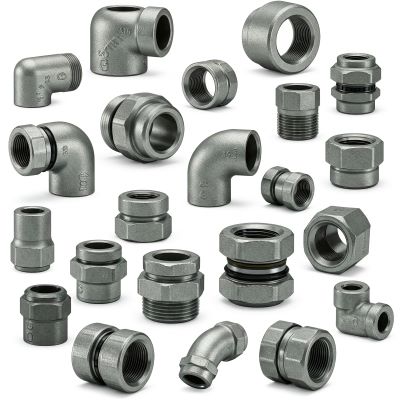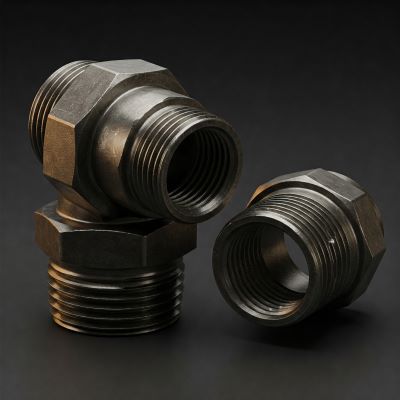Threaded connections are the backbone of countless industrial applications, from plumbing and hydraulics to pneumatic systems and beyond. The choice of thread type significantly impacts the performance, reliability, and longevity of any system. Two of the most common thread standards are G threads and NPT threads, each with unique characteristics and applications.
Understanding G Threads
What are G Threads and How Do They Work?
G threads, also known as BSPP (British Standard Pipe Parallel), are parallel threads with a 55-degree included angle. They are designed to create a seal using a separate gasket or sealant, such as PTFE tape or thread sealant.
Common Applications of G Threads in Different Industries
➡️ Hydraulics and Pneumatics: Widely used in high-pressure systems due to their robust sealing capabilities.
➡️ Plumbing and Gas Installations: Common in domestic and industrial plumbing systems.
➡️ General Engineering: Employed in various industrial applications where reliable sealing is crucial.
Advantages of Using G Threads for Threaded Connections
➡️ Stronger Seals: When properly sealed, G threads offer excellent resistance to high pressures and temperatures.
➡️ Versatility: Fits a variety of materials and applications.
➡️ Ease of Assembly: Relatively easy to assemble and disassemble, even in confined spaces.
Understanding NPT Threads
What are NPT Threads and Their Key Features
NPT (National Pipe Taper) threads are tapered threads with a 60-degree included angle. They rely on the taper to create a seal as the male thread is screwed into the female thread.
Where NPT Threads Are Commonly Used
➡️ Oil and Gas Industry: Widely used in oil and gas pipelines and equipment.
➡️ Plumbing and Gas Installations: Common in North America for gas and water lines.
➡️ General Industrial Applications: Found in various industrial settings where a self-sealing mechanism is required.
Benefits of NPT Threads for Specific Applications
➡️ Self-Sealing Mechanism: The tapered design creates a tight seal without the need for additional sealants.
➡️ Vibration Resistance: The tapered connection provides excellent resistance to vibration.
➡️ Widely Available: NPT fittings are readily available in various sizes and materials.
Key Differences Between G Threads and NPT Threads
Thread Angle and Shape
➡️ NPT threads are tapered, whereas G threads are parallel.
➡️ G threads have a 55-degree included angle, while NPT threads have a 60-degree included angle.
Sealing Mechanisms
➡️ G threads require a separate gasket or sealant for sealing.
➡️ NPT threads rely on the taper to create a self-sealing connection.
Standards and Specifications
➡️ G threads adhere to ISO standards.
➡️ NPT threads are defined by ANSI standards.
Why Choosing the Right Thread Type Matters for Your Project
Selecting the wrong thread type can lead to:
➡️ Leaks and Spills: Inaccurate sealing can result in fluid leaks, compromising safety and efficiency.
➡️ System Failure: Improper connections can weaken the system, leading to premature wear and tear.
➡️ Maintenance Headaches: Frequent repairs and replacements due to faulty connections increase downtime and costs.
➡️ Safety Hazards: Leaks in high-pressure systems can pose serious safety risks to personnel.
By carefully considering the specific requirements of your project, you can choose the optimal thread type, ensuring a robust and reliable system.
When to Choose G Threads
Projects Where G Threads Excel in Performance
➡️ Applications requiring high-pressure and high-temperature resistance.
➡️ Systems where vibration is a concern.
➡️ Installations where space is limited.
Factors to Consider When Selecting G Threads
➡️ Pressure and Temperature Requirements: Ensure G threads can withstand the operating conditions of the system.
➡️ Material Compatibility: Choose appropriate materials for the fittings and gaskets.
➡️ Sealant Selection: Select a suitable sealant for the application and ensure proper application.
Potential Limitations of G Threads
➡️ Reliance on Sealants: The effectiveness of the seal depends heavily on the correct application of the sealant.
➡️ Potential for Leaks: Improper sealing or damage to the gasket can lead to leaks.
When to Choose NPT Threads
Ideal Scenarios for Using NPT Threads
➡️ Applications where a self-sealing mechanism is preferred.
➡️ Systems subject to vibration and shock loads.
➡️ Installations where space constraints are not a major concern.
Evaluating the Durability and Versatility of NPT Threads
➡️ Material Considerations: Select appropriate materials for the fittings to ensure durability and corrosion resistance.
➡️ Application Considerations: Evaluate the suitability of NPT threads for the specific operating conditions of the system.
Challenges of Using NPT Threads in Certain Environments
➡️ Difficulty in Disassembly: The tapered design can make disassembly challenging, especially after prolonged use.
➡️ Potential for Over-Tightening: Over-tightening can damage the threads and cause leaks.
Compatibility and Conversion Between G Threads and NPT Threads
Adapters and conversion fittings are available to connect components with different thread types. These fittings ensure compatibility between G and NPT threads.
Ensuring a Secure and Leak-Free Connection
➡️ Use high-quality adapters and conversion fittings.
➡️ Ensure proper installation and tightening of the fittings.
➡️ Regularly inspect connections for leaks and signs of wear and tear.
Expert Tips for Seamless Thread Compatibility
➡️ Consult with experienced engineers or technicians for guidance on thread selection and compatibility.
➡️ Refer to relevant industry standards and specifications.
➡️ Use appropriate tools and techniques for installation and maintenance.
Common Mistakes to Avoid in Thread Selection
Misjudging Application Requirements
➡️ Failing to consider the specific operating conditions of the system.
➡️ Underestimating the importance of pressure and temperature ratings.
Overlooking Material and Pressure Specifications
➡️ Selecting materials that are not compatible with the fluids or environment.
➡️ Choosing fittings that are not rated for the required pressure and temperature.
Ignoring Industry Standards and Compliance
➡️ Failing to adhere to relevant industry standards and regulations.
➡️ Using non-compliant components that can compromise safety and performance.
Conclusion
By making informed decisions regarding thread selection, you can ensure the long-term reliability, safety, and efficiency of your industrial systems.
Recap of G Thread vs NPT Differences
➡️ G threads are parallel, while NPT threads are tapered.
➡️ G threads rely on external sealants, while NPT threads are self-sealing.
➡️ G threads are generally more suitable for high-pressure and high-temperature applications.
➡️ NPT threads are well-suited for applications subject to vibration and shock.
Guidance for Selecting the Best Thread Type for Your Project
➡️ Carefully analyze the specific requirements of your project, including pressure, temperature, vibration, and space constraints.
➡️ Consider the advantages and limitations of each thread type.
➡️ Consult with experienced professionals for guidance and recommendations.
➡️ Select high-quality components and ensure proper installation and maintenance.
Post time: Jan-22-2025



